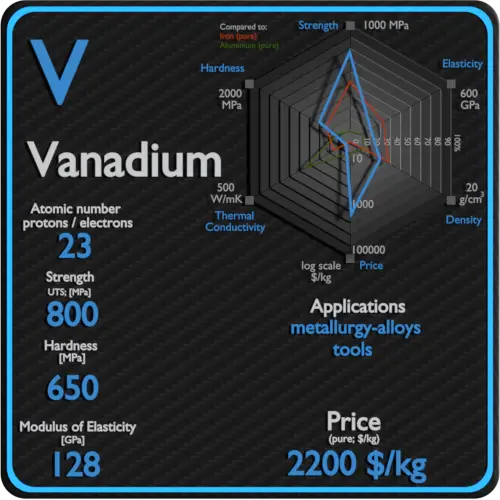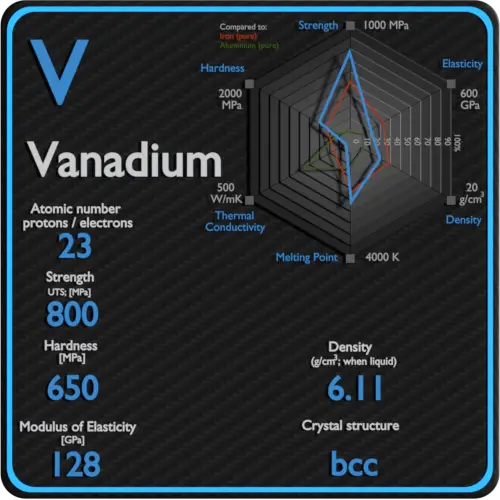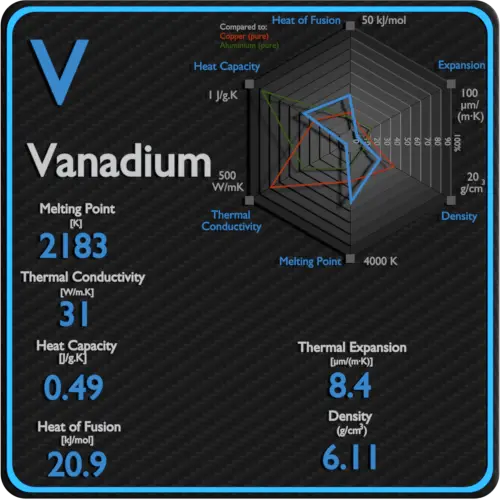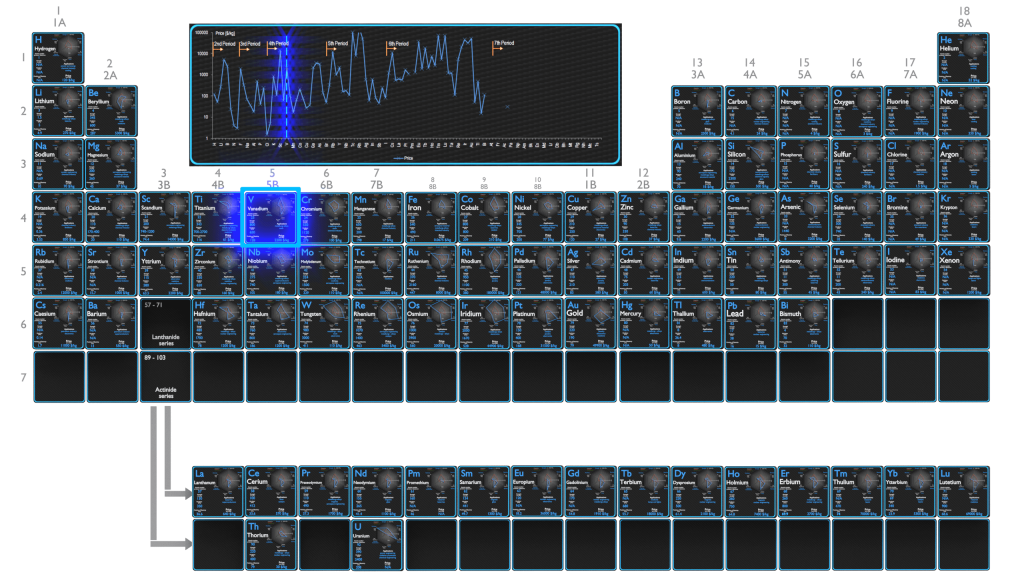About Vanadium
Vanadium is a hard, silvery grey, ductile, and malleable transition metal. The elemental metal is rarely found in nature, but once isolated artificially, the formation of an oxide layer (passivation) stabilizes the free metal somewhat against further oxidation.
Summary
| Element | Vanadium |
| Atomic number | 23 |
| Element category | Transition Metal |
| Phase at STP | Solid |
| Density | 6.11 g/cm3 |
| Ultimate Tensile Strength | 800 MPa |
| Yield Strength | 770 MPa |
| Young’s Modulus of Elasticity | 128 GPa |
| Mohs Scale | 6.7 |
| Brinell Hardness | 650 MPa |
| Vickers Hardness | 630 MPa |
| Melting Point | 1910 °C |
| Boiling Point | 3407 °C |
| Thermal Conductivity | 30.7 W/mK |
| Thermal Expansion Coefficient | 8.4 µm/mK |
| Specific Heat | 0.49 J/g K |
| Heat of Fusion | 20.9 kJ/mol |
| Heat of Vaporization | 0.452 kJ/mol |
| Electrical resistivity [nanoOhm meter] | 197 |
| Magnetic Susceptibility | +255e-6 cm^3/mol |
Applications of Vanadium
Vanadium is mainly used to produce specialty steel alloys such as high-speed tool steels, and some aluminium alloys. Vanadium is generally added to steel to inhibit grain growth during heat treatment. In controlling grain growth, it improves both the strength and toughness of hardened and tempered steels. Vanadium is added to promote abrasion resistance and to produce hard and stable carbides which being only partly soluble, release little carbon into the matrix. The most important industrial vanadium compound, vanadium pentoxide, is used as a catalyst for the production of sulfuric acid. The vanadium redox battery for energy storage may be an important application in the future.
Production and Price of Vanadium
Raw materials prices change daily. They are primarily driven by supply, demand and energy prices. In 2019, prices of pure Vanadium were at around 2200 $/kg.
Vanadium occurs naturally in about 65 minerals and in fossil fuel deposits. It is produced in China and Russia from steel smelter slag. Other countries produce it either from magnetite directly, flue dust of heavy oil, or as a byproduct of uranium mining. World vanadium reserves (that part of the identified vanadium resource that meets specified minimum physical and chemical criteria related to current mining and production practices) are estimated at about 15 million metric tons and it is likely suficient to meet vanadium needs into the next century at the present rate of consumption.
Source: www.luciteria.com
Mechanical Properties of Vanadium
Strength of Vanadium
In mechanics of materials, the strength of a material is its ability to withstand an applied load without failure or plastic deformation. Strength of materials basically considers the relationship between the external loads applied to a material and the resulting deformation or change in material dimensions. In designing structures and machines, it is important to consider these factors, in order that the material selected will have adequate strength to resist applied loads or forces and retain its original shape. Strength of a material is its ability to withstand this applied load without failure or plastic deformation.
For tensile stress, the capacity of a material or structure to withstand loads tending to elongate is known as ultimate tensile strength (UTS). Yield strength or yield stress is the material property defined as the stress at which a material begins to deform plastically whereas yield point is the point where nonlinear (elastic + plastic) deformation begins.
See also: Strength of Materials
Ultimate Tensile Strength of Vanadium
Ultimate tensile strength of Vanadium is 800 MPa.
Yield Strength of Vanadium
Yield strength of Vanadium is 770 MPa.
Modulus of Elasticity of Vanadium
The Young’s modulus of elasticity of Vanadium is 128 GPa.
Hardness of Vanadium
In materials science, hardness is the ability to withstand surface indentation (localized plastic deformation) and scratching. Brinell hardness test is one of indentation hardness tests, that has been developed for hardness testing. In Brinell tests, a hard, spherical indenter is forced under a specific load into the surface of the metal to be tested.
Brinell hardness of Vanadium is approximately 650 MPa.
The Vickers hardness test method was developed by Robert L. Smith and George E. Sandland at Vickers Ltd as an alternative to the Brinell method to measure the hardness of materials. The Vickers hardness test method can be also used as a microhardness test method, which is mostly used for small parts, thin sections, or case depth work.
Vickers hardness of Vanadium is approximately 630 MPa.
Scratch hardness is the measure of how resistant a sample is to permanent plastic deformation due to friction from a sharp object. The most common scale for this qualitative test is Mohs scale, which is used in mineralogy. The Mohs scale of mineral hardness is based on the ability of one natural sample of mineral to scratch another mineral visibly.
Vanadium is has a hardness of approximately 6.7.
See also: Hardness of Materials
Vanadium – Crystal Structure
A possible crystal structure of Vanadium is body-centered cubic structure.
In metals, and in many other solids, the atoms are arranged in regular arrays called crystals. A crystal lattice is a repeating pattern of mathematical points that extends throughout space. The forces of chemical bonding causes this repetition. It is this repeated pattern which control properties like strength, ductility, density, conductivity (property of conducting or transmitting heat, electricity, etc.), and shape. There are 14 general types of such patterns known as Bravais lattices.
See also: Crystal Structure of Materials
Crystal Structure of Vanadium

Thermal Properties of Vanadium
Vanadium – Melting Point and Boiling Point
Melting point of Vanadium is 1910°C.
Boiling point of Vanadium is 3407°C.
Note that, these points are associated with the standard atmospheric pressure.
Vanadium – Thermal Conductivity
Thermal conductivity of Vanadium is 30.7 W/(m·K).
The heat transfer characteristics of a solid material are measured by a property called the thermal conductivity, k (or λ), measured in W/m.K. It is a measure of a substance’s ability to transfer heat through a material by conduction. Note that Fourier’s law applies for all matter, regardless of its state (solid, liquid, or gas), therefore, it is also defined for liquids and gases.
Coefficient of Thermal Expansion of Vanadium
Linear thermal expansion coefficient of Vanadium is 8.4 µm/(m·K)
Thermal expansion is generally the tendency of matter to change its dimensions in response to a change in temperature. It is usually expressed as a fractional change in length or volume per unit temperature change.
Vanadium – Specific Heat, Latent Heat of Fusion, Latent Heat of Vaporization
Specific heat of Vanadium is 0.49 J/g K.
Heat capacity is an extensive property of matter, meaning it is proportional to the size of the system. Heat capacity C has the unit of energy per degree or energy per kelvin. When expressing the same phenomenon as an intensive property, the heat capacity is divided by the amount of substance, mass, or volume, thus the quantity is independent of the size or extent of the sample.
Latent Heat of Fusion of Vanadium is 20.9 kJ/mol.
Latent Heat of Vaporization of Vanadium is 0.452 kJ/mol.
Latent heat is the amount of heat added to or removed from a substance to produce a change in phase. This energy breaks down the intermolecular attractive forces, and also must provide the energy necessary to expand the gas (the pΔV work). When latent heat is added, no temperature change occurs. The enthalpy of vaporization is a function of the pressure at which that transformation takes place.
Vanadium – Electrical Resistivity – Magnetic Susceptibility
Electrical property refers to the response of a material to an applied electric field. One of the principal characteristics of materials is their ability (or lack of ability) to conduct electrical current. Indeed, materials are classified by this property, that is, they are divided into conductors, semiconductors, and nonconductors.
See also: Electrical Properties
Magnetic property refers to the response of a material to an applied magnetic field. The macroscopic magnetic properties of a material are a consequence of interactions between an external magnetic field and the magnetic dipole moments of the constituent atoms. Different materials react to the application of magnetic field differently.
See also: Magnetic Properties
Electrical Resistivity of Vanadium
Electrical resistivity of Vanadium is 197 nΩ⋅m.
Electrical conductivity and its converse, electrical resistivity, is a fundamental property of a material that quantifies how Vanadium conducts the flow of electric current. Electrical conductivity or specific conductance is the reciprocal of electrical resistivity.
Magnetic Susceptibility of Vanadium
Magnetic susceptibility of Vanadium is +255e-6 cm^3/mol.
In electromagnetism, magnetic susceptibility is the measure of the magnetization of a substance. Magnetic susceptibility is a dimensionless proportionality factor that indicates the degree of magnetization of Vanadium in response to an applied magnetic field.


























